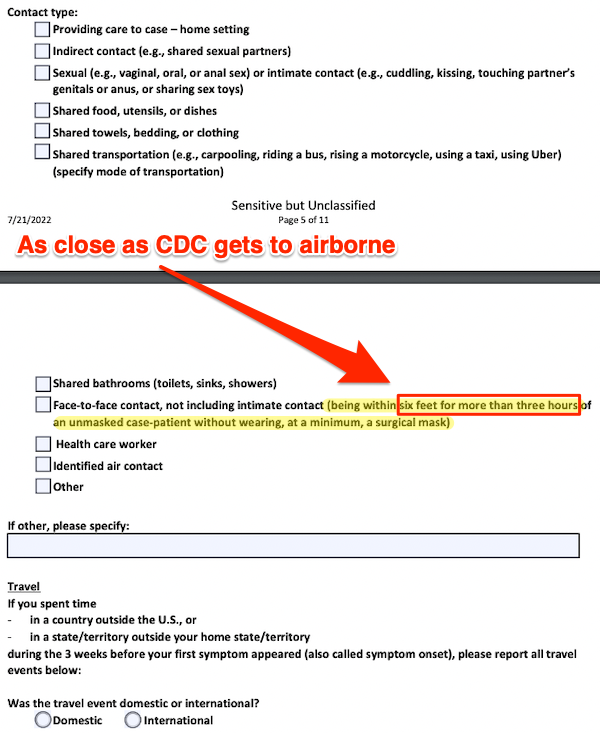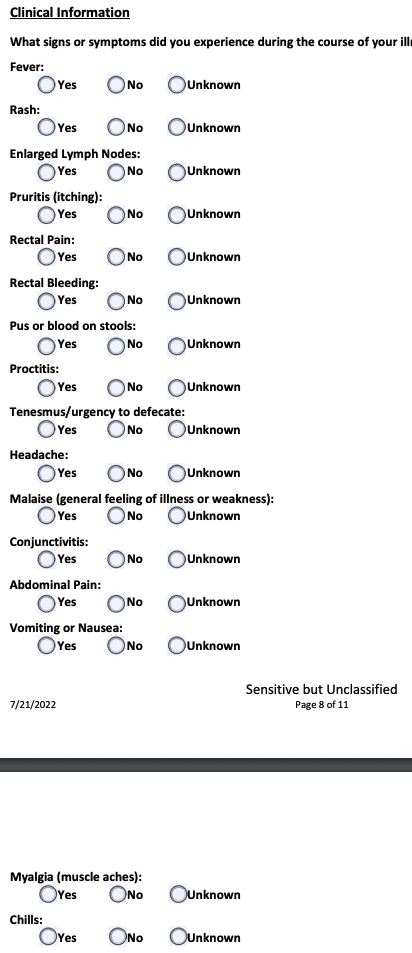By Lambert Strether of Corrente.
This short and sweet post will have two parts. First, I will show that the CDC Monkeypox case report form omits amy questions about airborne transmission. Then I will show why that’s a bad idea, inexplicable given CDC’s previous documentation on this point.
Caveat: I am not saying that “Monkeypox is airborne.” To my knowledge, we don’t have epidemiological studies of the same quality we have with Covid; the kind with seat charts and diagrams of airflow (as in the famous Skagit Valley chorus study, but with many others); that is the kind of evidence I rate highest, most of all because such studies show me how to imagine the ground and what to do. However, we do have sufficient information not to rule out airborne transmission altogether, as I will show. That CDC does this a priori — and at the start of what we all hope is not the start of another global pandemic on the order of Covid — is mind-boggling, or would be mind-boggling if we had not, by this time, had plenty of experience with how “The Centers for Disease” operates. They have form.
First, let’s look at the CDC case report, “OMB No. 0920-1011.” We have the “Short Form,” designed to be filled out by state or local health officials. We also have the “Data Dictionary Codebook” (same OMB number), which documents the database fields that will be populated by Short Form data entry. Both are embedded in the Appendix to this post. (The name “Short Form” suggests the existence of a “Long Form,” probably populating database fields unused by the Short Form, but if such a form exists, I haven’t seen it.
From transmission, the key section in the Short From is “History of Possible Exposures.” Here it is:

As you can see, the structured portion of the form (i.e. checkboxes and radio buttons) does not permit any representation of airborne transmission (certainly not a “fleeting contact” such as has occurred with Covid); airborne tranmission is ruled out a priori[1].
An interviewer desperate to somehow cram information about airborne transmission into the form could use the following text fields (“location of exposure,” “additional details”):

However, exactly because such data would be unstructured and unstandardized, it’s not likely to make it into any reports generated from the database.
We now turn to the Data Dictionary Codebook. As you can see, fields on the Short Form are mapped to fields in a database. Here is an example of how the documentation is structured:

As you can see, the basic structure is a series of field/value pairs, mutually exclusive (ORed radio buttons) or not (ANDed checkboxes). Hilariously, I found this field while searching for “air” (“prie”); no such luck. “Prairie Dog” strongly suggests that the Data Dictionary dates from no later than 2003, when “All people infected with monkeypox in this outbreak became ill after having contact with pet prairie dogs. The pets were infected after being housed near imported small mammals from Ghana. This was the first time that human monkeypox was reported outside of Africa.” But no doubt our thinking, and our fields, have been updated since that time.
We can also see from this example that the CodeBook contains many fields that are not used in the Short Form. Here is another example:

The word “mask” does not appear in the Short Form.
I scanned the entire codebook, and I can’t find any fields that would store data relevant to airborne transmission in the general case. (You can check my work in the Appendix.) For example, the famous Japanese 3Cs — closed spaces (with poor ventilation), crowded places (with many people nearby), and close-contact settings (such as close-range conversations), are highly structured and would lend themselves well to representation in a database. Here are more suggestions:
See those numbers on the left? Those are assigned to each answer.
Which means you can assign MORE numbers.
9. Same room with surgical mask.
10. Same room no mask.
12. Outdoors more than 6 feet.
13. Same room – 15 minutes after empty.
14. Hug and kiss on the cheek. pic.twitter.com/GxgYuS6C3p
— Lazarus Long (@LazarusLong13) August 11, 2022
We can conclude, then, that CDC simply is not enquiring into airborne transmission of Monkeypox. They have ruled it out, a priori. However, if you go by existing literature — including from the CDC itself — there’s plenty of reason consider it a real possibllity. To that literature we now turn.
First, from KHN, “CDC Posts, Then Deletes, Guidance On Airborne Risks Of Monkeypox“:
The Centers for Disease Control and Prevention says it removed the recommendation that travelers worried about monkeypox should wear a mask because it was causing confusion. Although public health officials have been linking many of the cases in this outbreak to close sexual contacts, monkeypox can also be spread through the air for short distances.
This is one of KHN’s handy wrap-ups. From the New York Times, “Monkeypox Can Be Airborne, Too.” So why not collect data on airborne transmision of monkeypox, if only to rule it out?
Then there’s Nature, “How does monkeypox spread? What scientists know.” What we “know” seems solid:
Several studies… show that few people contract the disease from an infected household member with whom they didn’t have sexual contact. This finding, paired with the data about viral load, suggests that respiratory droplets and airborne particles probably aren’t the primary transmission route… If corroborated by further research [which CDC has decided not to do, because reasons], it could call into question whether people should isolate for the entire duration of infection, which might be difficult because the illness seems to take up to a month to resolve, she adds.
But what we “know” melts into air:
Even if the virus can be sexually transmitted, it’s unclear how large of a role this mode of transmission has, compared with simply being in close, skin-to-skin contact with a person or [gawd, they can never say “aerosols”] — which also occur during sex.
Put more pointedly, during sex — hear me out — people share air, so any theory of skin-to-skin contact has an enormous confounding factor. So why not collect data on airborne transmision of monkeypox, if only to rule it out?
Now let’s do a (frankly cursory) review of the literature on airborne transmission of monkeypox.
CDC, “Smallpox & Other Orthopoxvirus-Associated Infections.” Here is CDC scrubbing it:
Monkeypox is airborne according to the Nigeria CDC and according to our CDC as of two days ago when they scrubbed that info from their site. It had matched the NCDC and had been there for at least two years. Coincidentally changed on the same day they told us to forget masks. pic.twitter.com/A2f7PupjYG
— Catherine Sterner
(@CathSterner) August 13, 2022
CDC, “Hospital Respiratory Protection Program Toolkit“:

CDC, “Potential Exposure to Person with Confirmed Human Monkeypox Infection” (via):

CDC, “Monkeypox in the Democratic Republic of the Congo“:

Coughing and sneezing is possibly droplets (loogies, ballistic). Talking (like singing) certainly includes aerosols, i.e. transmission is airborne.
But wait, there’s more from the CDC:
In 2003, the CDC not only knew airborne PPE was needed around Monkeypox patients but also staff handling soiled laundry since they explained the laundry could cause aerosolized particles to be inhaled. https://t.co/LQji4k01M2 pic.twitter.com/FeMKxAakBV
— Nicolas Smit (@PPEtoheros) August 8, 2022
GOV.UK, “High consequence infectious diseases (HCID)“:

And finally, Clinical Infectious Diseases, “The Clinical Characteristics of Human Monkeypox, and Risk Factors for Severe Disease.” Figure 1 lists the upper and lower respiratory tract symptoms — arguably related to breathing, not touch — the researchers studied.:

Oddly, the CDC’s “Short Form” has eliminated all these symptoms, even coughing:

Again, why not collect data on airborne transmision of monkeypox, if only to rule it out?
In list form:
1) Why won’t CDC collect data on airborne transmission of monkeypox, if only to rule it out?
2) Why won’t CDC collect data on airborne transmission of monkeypox, if only to rule it out?
3) Why won’t CDC collect data on airborne transmission of monkeypox, if only to rule it out?
4) Why won’t CDC collect data on airborne transmission of monkeypox, if only to rule it out?
5) Why won’t CDC collect data on airborne transmission of monkeypox, if only to rule it out?
6) Why won’t CDC collect data on airborne transmission of monkeypox, if only to rule it out?
7) Why won’t CDC collect data on airborne transmission of monkeypox, if only to rule it out?
8) Why won’t CDC collect data on airborne transmission of monkeypox, if only to rule it out?
9) Why won’t CDC collect data on airborne transmission of monkeypox, if only to rule it out?
10) Why won’t CDC collect data on airborne transmission of monkeypox, if only to rule it out?
And so forth. One hesitates to use the word “farce” for CDC”s “science” here, if only because stronger words come to mind.
NOTES
[1] CDC might not be so strong on transmission, but hoo boy! Did they lavish attention on data structures for gender and race (although not, naturally, proxies for class like income or education level).
APPENDIX: CDC Form OMB No. 0920-1011E (“Short Form”) and Data Dictionary Codebook
The Short Form:
The Data Dictionary Codebook:


